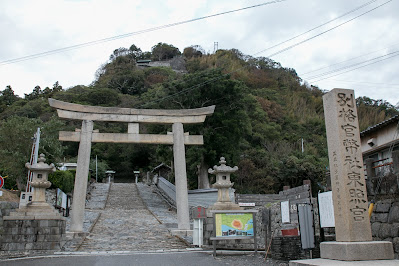Kunozan Castle
-Originally castle but famous as Toshogu shrine-
Overview
Name: Kunozan Castle (Kunozan-jo)
Place: Negoya Suruga-ku Shizuoka city, Shizuoka
Type: Mountain Castle
Built: 1568
Remaining remnants: Buidings of Kunozan Toshogu Shrine
Title: National treasure (as Kunozan Toshogu Shrine)
Brief History
Kunozan mountain is placed next of Nihondaira height, a famous scenic area of Mt. Fuji behind of Suruga bay, but being separated by large valley the mountain is an isolated one. The top of the mountain has wide ocean view of Suruga bay, and it was appropriate to watch sea transportation at the area.
Built and usage of Kunozan castle
Originally there was a temple named Tesshuji at the site of the castle. In 1568, Shingen Takeda (1521-1573), a warlord of Kai province (Yamanashi prefecture), deprived Suruga province (middle part of Shizuoka prefecture) including Shizuoka area from Imagawa clan, but faced counter attack of Hojo clan, the warlord of Sagami province (Kanagawa prefecture) and still supported Imagawa clan.
Shingen thought the Kunozan mountain is suitable for castle, thus he compulsory moved Tesshuji at the hillside and newly built a castle. With a steep cliff and comparatively wide hilltop area, Kunozan castle was an impregnable fortress and regarded as one of three secure mountain castles of Takeda clan along with Iwadonoyama castle (Yamanashi prefecture) and Iwabitsu castle (Gunma prefecture).
The structure of castle is supposed to be the following. At the top of the mountain there was a narrow watching space, and buildings were spread on terraces below peak. Secondary area is located at current ropeway station, and third area exist at the south of secondary area. There was a gate at the south edge of hill top area, and connected to outside by long steps.
Takeda clan used Kunozan castle both for local fortress and naval base. At the fall of Takeda clan in 1582, Kunozan castle opened and surrendered to Ieyasu Tokugawa (1543-1616), the warlord of Mikawa province (eastern part of Aichi prefecture) who was an ally of central ruler Nobunaga Oda (1534-1582). Kunozan castle had used about 20 years after that, but was abolished at the beginning of 17th century.
Construction of Kunozan Toshogu shrine
Ieyasu Tokugawa became the first Shogun of Edo Shogunate in 1603, but succeeded it to his son Hidetada Tokugawa (1579-1632) in 1605. Ieyasu chose Sunpu city (Shizuoka city) where he lived at childhood and middle age as his retirement place, and stayed Sunpu castle until his death in 1616. Facing death, Ieyasu left the will stating his body was to be buried at Kunozan mountain, as Kunozan was the key point to defense Sunpu city.
Ieyasu was treated as god after his death, and his son Hidetada started to build a shrine commemorating Ieyasu utilizing ruin of former Kunozan castle in the same year. After two years construction, a splendid shrine named Kunozan Toshogu (久能山東照宮) completed in 1617, regarded as one of three major Toshogu shrine dedicated to Ieyasu in Japan (Other two are Nikko Toshogu (Tochigi prefecture) and Senba Toshogu (Saitama prefecture)).
The inner shrine and outer shrine located the place of former central area, and the building was a beautiful stylish one decorated with black Japanese lacquer and many sculpture (This style is named as Azuchi Momoyama style, and main tower of Osaka castle at the period of Hideyoshi Toyotomi was said to be built in this style). Above the inner shrine there was a place where Ieyasu was buried, and many attached buildings and gates exist before the inner area. Formerly a five story Buddhism tower was built, but this was dismantled at the time of Meiji revolution.
Even though smaller than Nikko Toshogu, Kunozan Toshogu was also an important place where Ieyasu sleeps and Kunozan Toshogu was maintained by Edo government throughout Edo era. Today many building still remain as original, and this shrine was nominated as a National Treasure in 2010. Now Kunozan Toshogu became a famous sightseeing place along with Nihondaira height. Concealed by splendid buildings, but today we can find trace of old castle with careful look here and there.
Access
40 minutes drive from Tomei Expressway Shimizu interchange to the top of Nihondaira and use Nihondaira Ropeway, or park at south hillside and walk up 20 minutes. Shizutetsu Justline bus from JR Central Tokaido Shinkansen line / Tokaido honsen line Shizuoka station to Nihonaira busstop and also use Nihondaira ropeway.
Related Castles
Sunpu Castle -Place of memory for first Shogun-
Iwadonoyama Castle -Shameful betrayal or undoubted right-
Iwabitsu Castle -Strategic base of Sanada clan-























































































































































No comments:
Post a Comment